Hike report - 2013
Place
New Forest
Dates
24th – 27th January 2013
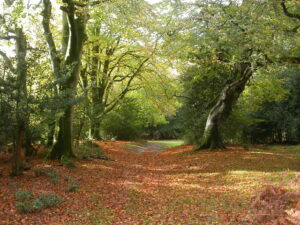
Hikers
Graham Beevor, Peter Cox, Alan (Curly) Durrant, Martin Hime, Simon Hime, Phil Knowles, Laurie Noble, Drew Rush, Malcolm Rush and Geoff Wright
Report
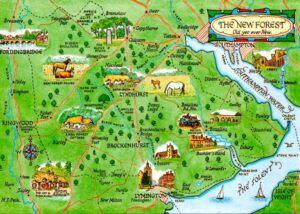 This year we decided to spend our time hiking in the New Forest for the first time since 1972, before it had been designated a National Park, that being achieved in 2006.
This year we decided to spend our time hiking in the New Forest for the first time since 1972, before it had been designated a National Park, that being achieved in 2006.
As usual we assembled on the Thursday evening, with Graham, Peter and Laurie arriving at the Guest House – Heather House – before Geoff and then Phil. It was the first time in 5 years that our accommodation had not been in a seaside town.
We then set off for the pub and met Curly, Martin and Simon as they drove through town towards the guest house.
Drew and Malcolm arrived last, blaming their late arrival on their slow drive through North Finchley, where they paid their respects to Robert Dyas, the store we used to frequently meet outside for previous winter hikes.
The Waterloo Arms is a long walk from the guest house. It’s a small but nice pub off the main road that served soup in a hollowed-out loaf of bread and excellent custard, although not together. There was the usual catching up with everyone’s news from the past year, including Peter’s experiences as a Games Maker at the London 2012 Olympic Games.
We stopped for a final drink at the Mailman’s Arms before making our way back to Heather House, just after the Italian restaurant on the A35 East out of Lyndhurst.
Back at the guest house we discovered that breakfast orders should be written on a slip of paper by 9pm the previous evening, and we wondered if there might be a Fawlty Towers type experience in store for us. We need not have worried as it was very friendly. They also received the support of Phil who, it emerged, had previously stayed there during one of his outings with the MG Club.
Friday
The breakfast was good and flasks were filled, although Curly managed to break his by over-energetic stirring. As the hike was to start and finish at Heather House we put on our boots and ensured that the packed lunches we would need were properly stored in our rucksacks.

It was a bright cold day but the winter had been wet and there were some fears that the going would be very wet and muddy. It was about 9.30am as we strode along the A35 to start the first of two hikes in what William the Conqueror had designated as a royal forest and hunting ground. We used the underpass to get to the south side of the road and then headed across the heathland to the trig point.
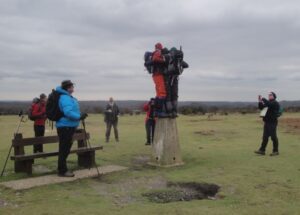 There was plenty of merriment as Malcolm, Simon and Martin managed to get on top of trig point at the same time – albeit briefly.
There was plenty of merriment as Malcolm, Simon and Martin managed to get on top of trig point at the same time – albeit briefly.
We eventually set off again, heading roughly east, first along Park Pale (an ancient bank and ditch which enclosed the Lyndhurst Old Park), and then a path to the edge of Matley Wood. We had to wait there for a short while whilst the bomb disposal team dealt with a 3-lb trench mortar from World War I.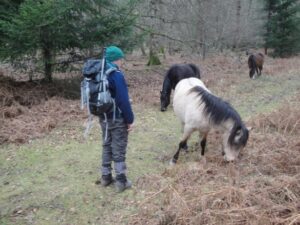
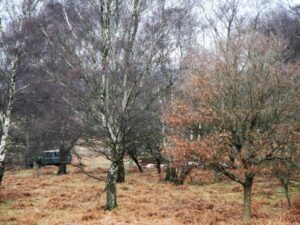 Once the all clear was given we proceeded through the wood out to the open area, across and through Kings Passage (one of the few safe crossing points on the Beaulieu River). There had been two more brief stops on the way – one to admire the New Forest ponies and the other so Martin could climb a tree.
Once the all clear was given we proceeded through the wood out to the open area, across and through Kings Passage (one of the few safe crossing points on the Beaulieu River). There had been two more brief stops on the way – one to admire the New Forest ponies and the other so Martin could climb a tree.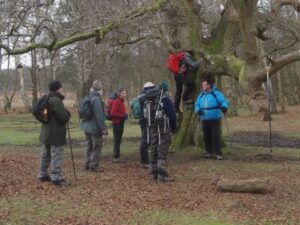
After crossing the river we headed east to the railway track and followed it south to Beaulieu Road Station. After the station went south and south west to the lunch stop on the edge of the wood.
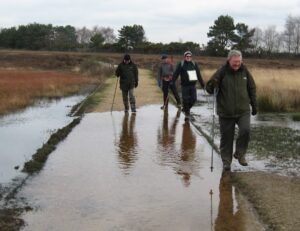 First we had to negotiate our way across a shallow ford. The only sensible way to avoid getting our boots soaking wet was to edge our way along the raised edge of the path, using our walking sticks to help us to retain our balance.
First we had to negotiate our way across a shallow ford. The only sensible way to avoid getting our boots soaking wet was to edge our way along the raised edge of the path, using our walking sticks to help us to retain our balance.
To eat our lunch we sat on a fallen tree out of the cold wind, although Malcolm did light a small illegal fire made of birch bark (using only one match), to add some warmth.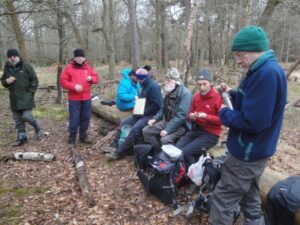

After lunch we followed woodland tracks south west and west, for about 3 miles, through the woods where the paths were muddy, to Balmer Lawn Hotel. Although some of the tracks were not marked on the map, Geoff knew the area well and was in fact using his orienteering map to navigate the way. We saw more ponies and a deer.
From the hotel it was a short walk north west to the A337 where we crossed the road and re-entered the wood to follow the north bank of the Lymington River.
Despite problems, where the flood water was obstructing the path, we reached Bolderford Bridge where a passing cyclist took a group photo. We then hiked generally north and north east to Foxlease, the Girl Guiding campsite and training centre.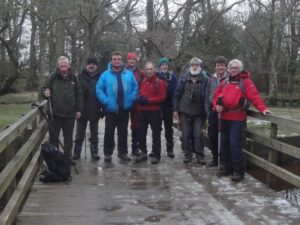
From there we followed the A337 north back to Lyndhurst, arriving in time to refresh ourselves at a local tea shop.
Graham checked his map and reckoned we had covered nearly thirteen miles. It was just after 5pm when we got back to Heather House, having stopped again briefly this time to look in the Ferrari and Maserati showrooms.
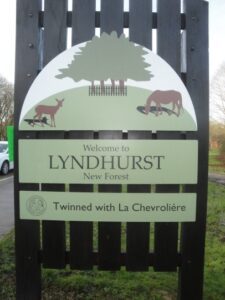 After a shower and change of clothes it was off to the Stag Hotel for a drink, before moving onto the Imperial China Szechuan Restaurant where most of us shared a ‘Let us Decide’ feast. It was superb and included a couple of ‘bonus’ dishes that were provided free. Several of us thought that it was possibly the best Chinese meal we had ever had during one of our hike weekends.
After a shower and change of clothes it was off to the Stag Hotel for a drink, before moving onto the Imperial China Szechuan Restaurant where most of us shared a ‘Let us Decide’ feast. It was superb and included a couple of ‘bonus’ dishes that were provided free. Several of us thought that it was possibly the best Chinese meal we had ever had during one of our hike weekends.
When we left the restaurant it was raining hard so we took shelter in the Stag and had another drink. The rain did not stop, so we got wet going back to the guest house, at the end of what had been a fairly exhausting day.
Saturday
After another good breakfast we set off (minus Peter, who had aggravated an old injury in his chest and had decided not to join us) for our second full day of hiking.
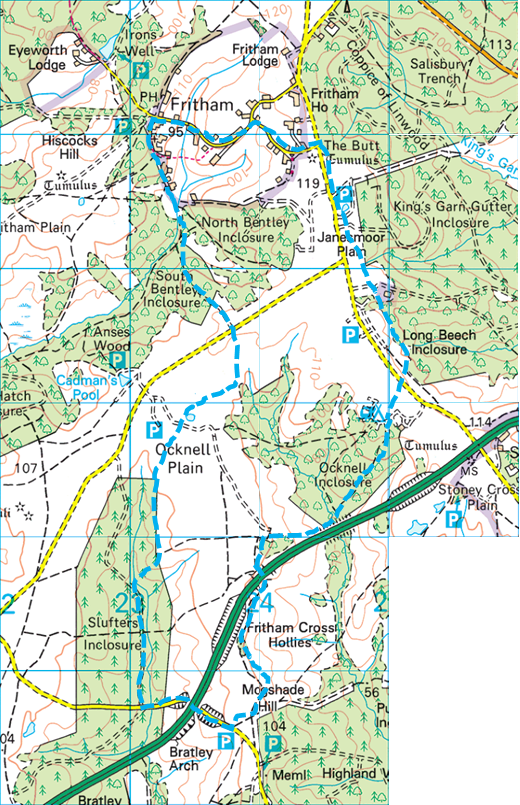
We drove west out of Lyndhurst, through Emery Down and along the road towards Bolderwood. On the way we passed the Portuguese Fireplace, a memorial to the men of the Portuguese army who occupied a hutted camp on the site during the First World War. With many of the local foresters away fighting they assisted the depleted workforce in producing timber for the war effort. The fireplace is what remains of the cookhouse of the camp.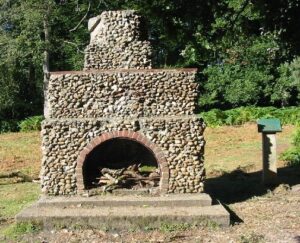
Our starting point was a car park just south of the A31. The rain had stopped during the night and the weather was fine – probably a couple of degrees warmer than Friday. We left the cars at about 10am and followed the path across the open heath land and through the underpass to the north side of the A31.
 From the other side of the underpass we navigated our way round towards the spot where the Ocknell Inclosure meets the road, and picked up the footbath through the wood. This went north east and came out at a campsite close to the edge of the wood and the remains of some old runways belonging to the old Stoney Cross airfield, used during the Second World War.
From the other side of the underpass we navigated our way round towards the spot where the Ocknell Inclosure meets the road, and picked up the footbath through the wood. This went north east and came out at a campsite close to the edge of the wood and the remains of some old runways belonging to the old Stoney Cross airfield, used during the Second World War.
We continued north east crossing the location of one of the old runways which had been dug up, but was still clear on the ground. When we reached Long Beech Inclosure we turned north along the edge of the wood, across Janesmoor Plain and past Janesmoor Pond, until we reached the road junction signposted to Fritham.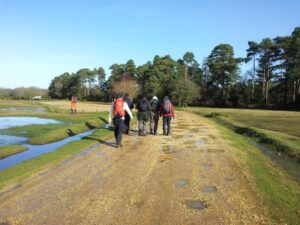
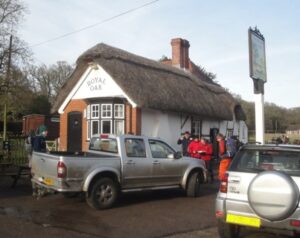 We followed the road into Fritham and made for our lunch stop – The Royal Oak, the smallest pub in Hampshire.
We followed the road into Fritham and made for our lunch stop – The Royal Oak, the smallest pub in Hampshire.
It was already crowded, so as the sun was still shining, we decided to eat outside in the large garden, where we were also joined by Peter, who had driven out to meet us. The entire menu was based on a Ploughman’s Lunch with a choice of either, meat, fish or the traditional Cheddar Cheese.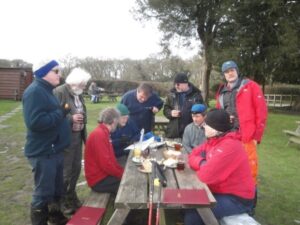
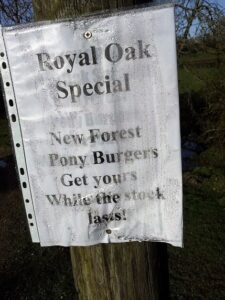 The Pony Burgers had unfortunately sold out.
The Pony Burgers had unfortunately sold out.
As we sat enjoying the food we assisted Malcolm with his crossword and listened to the dulcet tones of a Song Thrush.
Once we had eaten we started to feel a bit chilly so went back into the pub to warm up. With ten of us in the bar it was even more crowded. For some reason, Phil led us in the singing of a sea shanty that we continued with as we left the pub.
The afternoon route took us paddling southwards through a lot of marshy waterlogged ground, Geoff was still using his Orienteering maps that enabled us to follow a more direct route back, rather than having to stick to the paths shown on the OS maps we usually use. We headed south through South Bentley Inclosure, that involved crossing a footbridge and a stream where Laurie failed to jump fully across. It was one of those “you’ve been framed” moments, but none of us had been filming.
It was then across the road, over some more old runway tracks and across Ocknell Plain until we reached the northern edge of Ocknell Inclosure. We turned south west towards the corner of Slufters Inclosure, passing Ocknell pond on the way.
The bulk of the remainder of the hike, before reaching the road and returning to the cars, was spent walking through Slufters Inclosure.
The weather had been fine and clear, we saw a tawny owl, more ponies and deer, and enjoyed the greens and browns of the trees and bracken that were spectacular in the sunlight. We had covered about 9 miles.
From the car park we drove a short distance to visit the nearby Canadian War Memorial. This is a simple wooden roadside cross overlooking sloping ground, close to the Bolderwood Deer Sanctuary.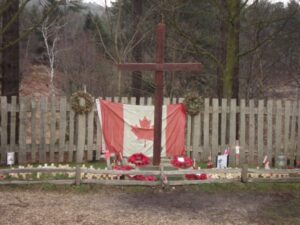
It recalls World War Two Canadian forces present in the New Forest before the D-Day invasion of 6th June 1944. At this site, during the build-up to D-Day, Canadians of all denominations who were stationed in the area would regularly gather for church services.
On D-Day Royal Canadian Army Service Corps soldiers of the 3rd Canadian Division and 2nd Armoured Brigade landed on Juno Beach and suffered fourteen fatalities.
After returning to Heather House, Graham, Geoff and Drew walked back into Lyndhurst for another afternoon tea. Later in the evening we all met at the Fox and Hounds before moving on the Passage to India restaurant, where Geoff had a venison curry for the first time but wasn’t too impressed.
There was light rain as we left this time, and we again had a final drink at the Stag Hotel before retiring for the night.
Sunday
Breakfast was again good, supporting the fact that many of us thought that Heather House was probably the best B&B we had stayed at.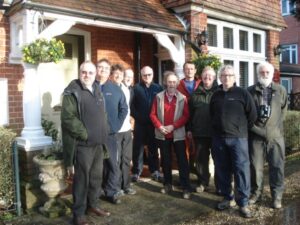
There had been heavy rain overnight but the weather was kind and it cleared up by 8am and was fine from then on. Once again it was an improvement on the previous day.
A vote decided that the final day’s walk would be near Winchester, which for most of us was on the way home. We settled our bills, took our customary group photo, said goodbye to Peter and set off in the cars, up the M3 to the Bridge Inn at Shawford.
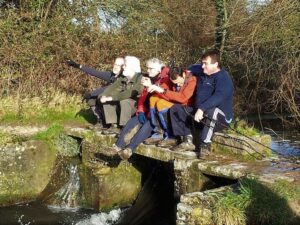 From the pub car park we found the footpath heading north along the bank of the River Itchen Navigation and then under the motorway to St Catherine’s Hill. Although our official route was to skirt the south side of the hill before crossing the motorway, Geoff, Malcolm, Martin and Simon decided to go over the top, where there was a superb view of Winchester.
From the pub car park we found the footpath heading north along the bank of the River Itchen Navigation and then under the motorway to St Catherine’s Hill. Although our official route was to skirt the south side of the hill before crossing the motorway, Geoff, Malcolm, Martin and Simon decided to go over the top, where there was a superb view of Winchester.
As the breakaway group took a bit longer to reach the motorway crossing the rest of us found somewhere comfortable to sit and wait, although none of us was quite sure how comfortable Curly was, sitting on top of a post.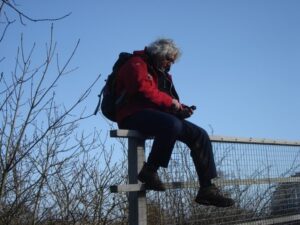
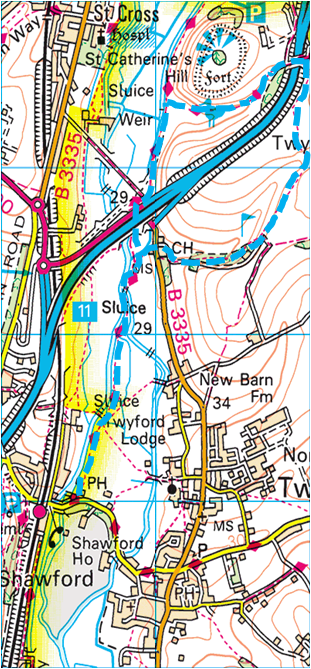 From the other side of the M3 we headed south around the edge of the golf course.
From the other side of the M3 we headed south around the edge of the golf course.
On the way we passed a stone memorial bearing the inscription “This land was ravaged by …” and included the names of C. Parkinson, J. Major, M. Thatcher and various other politicians, who protesters claimed had primarily been responsible for ensuring the motorway was built, in spite of sustained objections.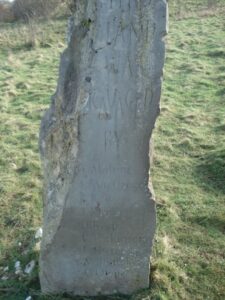
We met the road at the entrance to the Golf Club and went south west to Compton Lock before re-joining the footbath to retrace our route along the Itchen Navigation, back to the Bridge Inn. It had been a pleasant morning walk, covering about 5 miles.
For the third day in a row we ate lunch outside, but this time there was a patio umbrella and a heater.
As no-one had volunteered to record this year’s Winter Hike we decided to make it a joint effort. During lunch, everyone, between mouthfuls, made a contribution which Malcolm carefully recorded on a paper serviette supplied by the Bridge Inn. This report has therefore been written using those notes as its main source.
